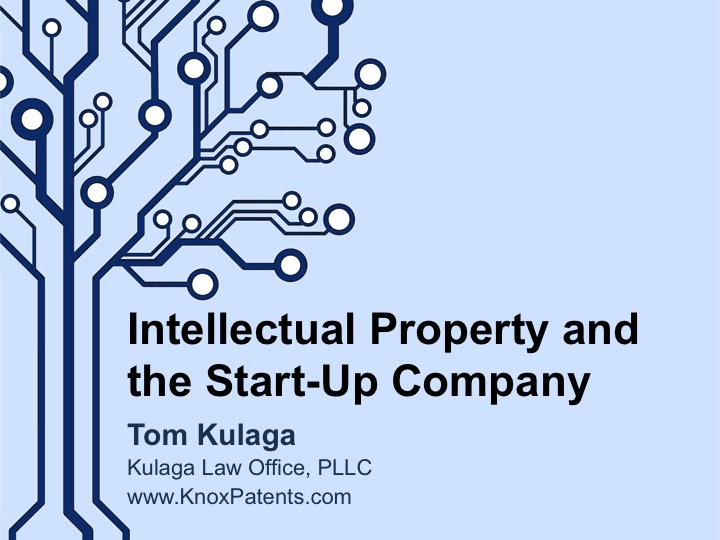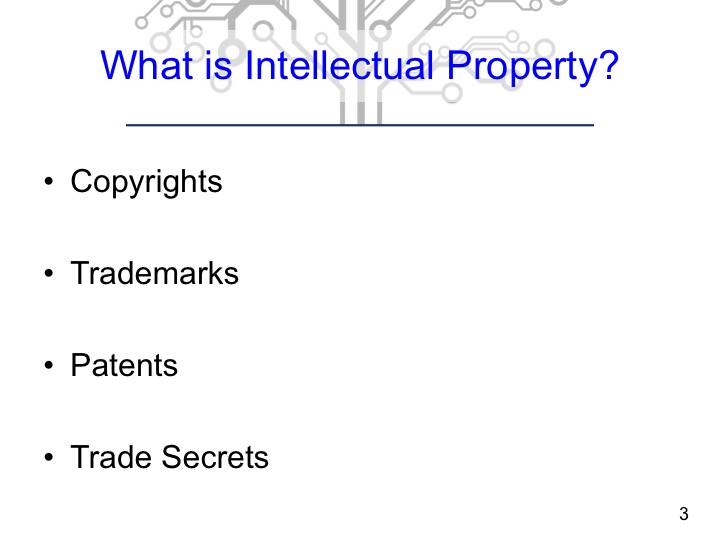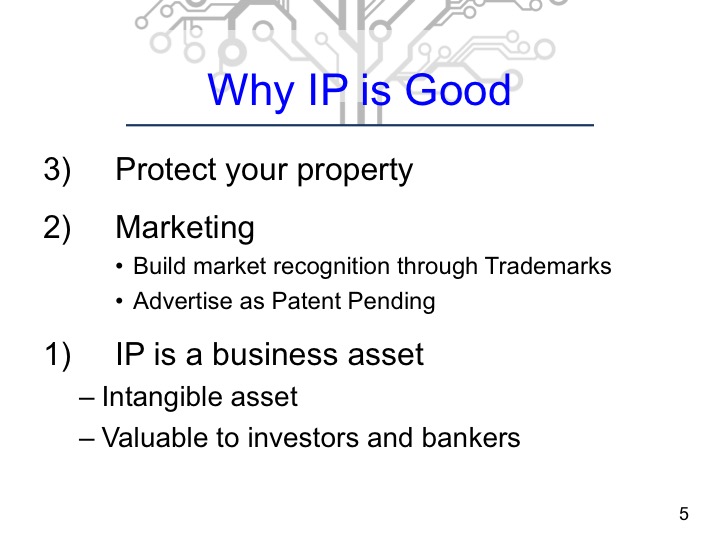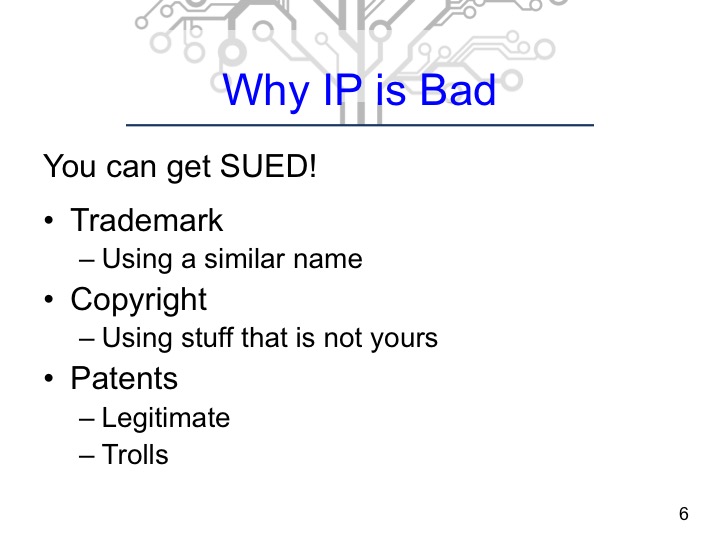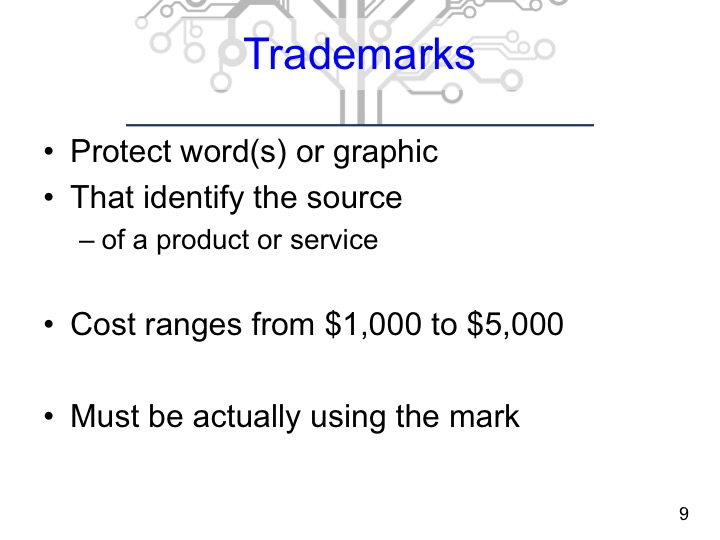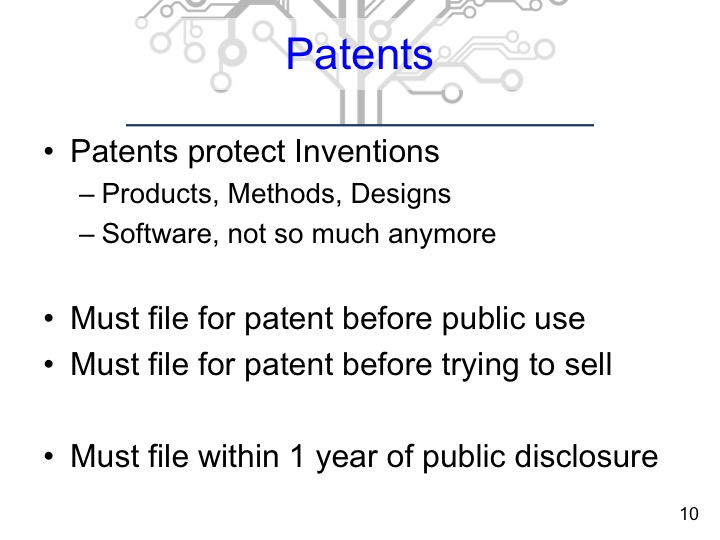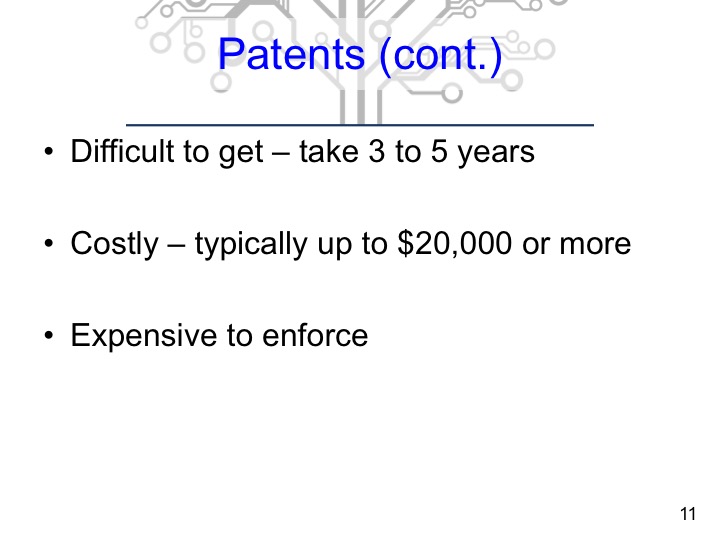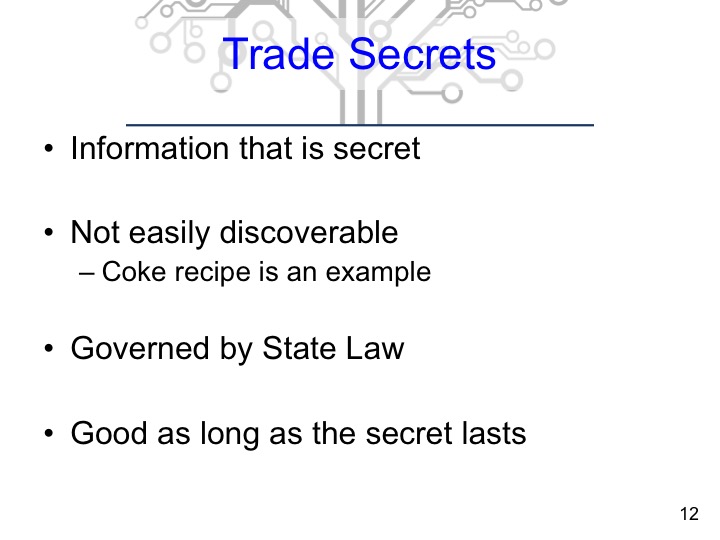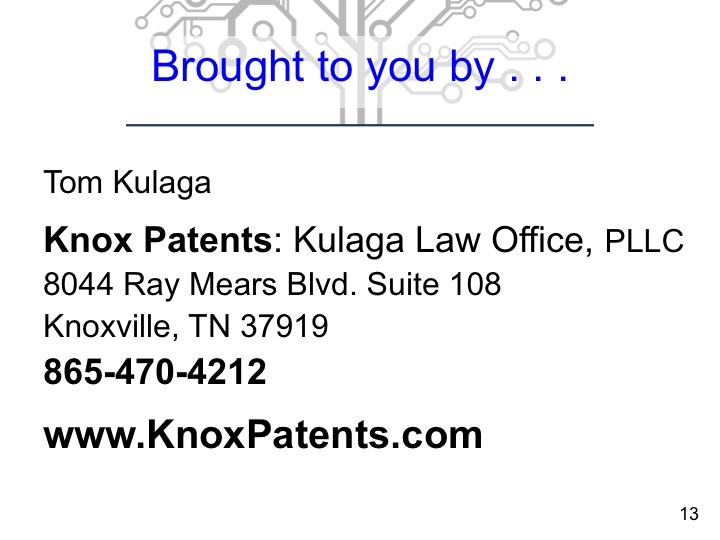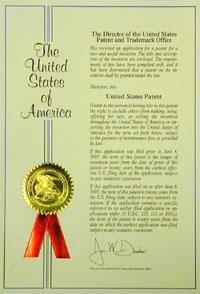The following information is an overview of the presentation Tom Kulaga made at the 2015 CodeStock Conference.
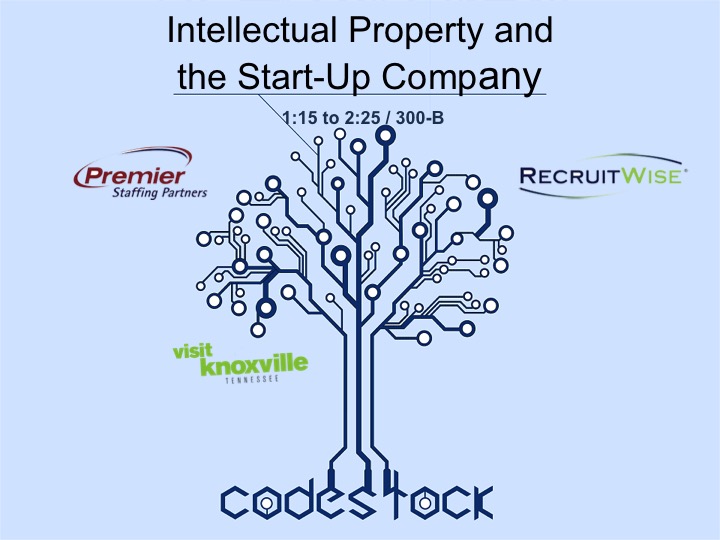
Intellectual property (IP) Includes copyrights, trademarks,
patents, and trade secrets. This creative and knowledge based property is
important for start-up companies.
A start-up company may own IP for many reasons. Three common
reasons include protection, marketing, and, most importantly, establishing a
business asset. Protection: Intellectual property is protectable from
unauthorized use by others. That helps reduce competition and increase market
share. Marketing: Trademarks are invaluable for establishing a brand.
Advertising patented or patent pending may be valuable for distinguishing a
product in the marketplace. Business Asset: Intellectual property is
intangible business property. It is an asset that has value like any other
business property. Intellectual property is particularly appealing to investors
who like the comfort of knowing the company owns more than the people capital.
Start-up companies need to be wary of IP owned by others. Any
IP infringement, even if unintentional, can result in the company being sued. This
can be particularly damaging to a start-up company at a time when it needs to
use its funding to grow and establish its business.
Copyright Protection
Copyrights protect creative expressions. A creative
expression is any original work by an author, published or unpublished. Common
examples include books, music, and movies. For software, source code and object
code can be copyrighted. So can the output and display screens, particularly
for games.
You cannot copyright protect titles, names, slogans, short
phrases, recipes, or forms. Nor can you copyright protect inventions, ideas, or
discoveries.
A copyright exists as soon as the work exists in a fixed
form. But a copyright can only be enforced after it is registered with the US
Copyright Office. By default, the author owns the copyright except work made
for hire, where the employer owns it.
To register a copyright a copyright application must be
filed. The application is a simple form that can be done on-line at
www.copyright.gov The Copyright Office changes a fee of $35 for on-line
applications. Revisions and derivative works must be separately registered,
although they will reference the original work.
In order to enforce a copyright it must be first registered.
If the copyright is registered before the infringement, statutory damages can
be collected. The statutory damages range from $750 to $30,000 per infringed
work. Damages can go as high as $150,000 if the infringement was willful or as
low as $200 if innocent.
Copyright Infringement
Any unauthorized use or copying of another's copyright
protected work can result in a lawsuit for copyright infringement. Literal
infringement is where part or all of the copyrighted work is copied and used or
sold. Software has additional risks because some courts find copyright
infringement for copying the sequence, structure, and organization of another's
software. A prime example of this is the recent case of Oracle America, Inc.
v. Google, Inc.. Google used the Java API headers for the Android operating
system. On appeal, the court determined that the sequence, structure, and
organization of the Java API is copyrightable. The case is still pending to
determine if Google's use falls under the Fair Use exception.
Fair use is copying of copyrighted material that is not
considered infringing. Fair use is not well defined, but relies upon a
subjective evaluation of the facts. Typically, four factors are evaluated: 1)
the purpose and character of the use, 2) the nature of the copyrighted work, 3)
the amount and substantiality of the portion taken, and 4) the effect of the
use upon the potential market. As is often the case with disputes that end up
in court, the final outcome may be determined by who is the "good
guy" and who is the "bad guy." See Stanford document on Fair Use and U.S. Copyright Office Fair Use Index
Trademarks
A trademark is a
word, phrase, symbol, or design that identifies the source of a product or
service. A service mark is the same as a trademark, except it relates to a
service as opposed to a product.
The strongest trademarks
are whimsical or arbitrary, for example, Kodak® and Verizon®.
Generic or descriptive marks cannot be enforced as trademarks. Neither are
marks that are deceptively mis-descriptive. Suggestive trademarks are those
that are not descriptive, but invokes the consumer's imagination to link the
product to the trademark. Word marks are typically considered stronger than
design marks or logos.
A trademark can be a
common law mark, it can be registered by the state, or it can be federally
registered through the Patent and Trademark Office (PTO).
A common law mark is a trademark that is protected because it is being used and treated as a
trademark. The superscript TM designates a trademark that is not registered. Common law trademarks have the
weakest protection of the three types.
A state registered trademark offers limited protection of the trademark against others in the
state using confusingly similar marks for the same or related products. A state
trademark registration does not protect the mark owner from others using the
same mark outside the state.
A federally registered trademark is the strongest form of trademark protection available in the
United States. Federally registered trademarks use the symbol ® to identify the mark as federally registered. The PTO operates a web
site in which owners can file an application to register their
trademark. Trademark applications can be filed before or after they are
actually used in interstate commerce. But the mark must be used in commerce
before it can be fully registered.
A federal trademark application requires that the owner file an application and pay a filing fee. To
be registered, the trademark must be in actual use in commerce, although, the
application can be filed before the use starts. This establishes an early
priority date. The cost to obtain a federal trademark typically ranges from
$1000 to $5000. It is also advisable to perform a trademark search before
filing the application.
Trademark infringement is the unauthorized use of a
trademark for related goods or services. Infringement also includes using a
mark similar to another's trademark where there is a likelihood of confusion
between the two marks.
Patents
A patent gives the patent owner a limited monopoly
for what is claimed in the patent. A patent embodies a property right granted
by the Government of the United States of America. That right is for the owner “to
exclude others from making, using, offering for sale, or selling the invention
throughout the United States or importing the invention into the United States”
for a limited time in exchange for public disclosure of the invention when the
patent is granted.
Patents issued in the United States are either a Utility
Patent, a Design Patent, or a Plant Patent. Utility patents protect the
functional aspects of an invention and are enforceable for 20 years after the earliest
filing date. Utility patents include a written description of the invention, including
how the invention is made and used. The features of the invention must also be
illustrated in drawings. Most importantly, a utility patent includes claims
that define what the patent protects.
Design patents protect the aesthetic design or
appearance of an invention and are enforceable for 14 years after the patent issue
date. Because a design patent protects the aesthetic appearance of an invention,
the drawings are the claims defining what is being protected. Generally, it is
best to prepare the design patent after the production prototype is completed
so as to capture the design that is planned on being sold.
Plant patents protect invented or discovered,
asexually reproduced plant varieties. There are few plant patents. Knox Patents
does not prepare plant patent applications.
Two primary requirements for having a United States
patent issue is that the invention be novel, never been done before, and
that the invention not be obvious, based on what has been done before. These
two requirements are closely examined by the Patent and Trademark Office (PTO) during
the examination of a patent application.
There are other requirements that need to be
noted. Effective March 16, 2013, the United States has a First to File
system instead of the previous First to Invent system. A inventor cannot
get a patent if there was a public use or an offer for sale
before the patent application was filed. With respect to public
disclosure, it is typically best if a patent application is filed before
any public disclosure, although the inventor has a year to file a patent
application after the first public disclosure.
Disclaimer
The information in this document is not legal advice. The
information provides a brief, general statement of intellectual property law
for the United States. It is always advisable to seek the advice of an attorney
regarding your specific circumstances, rather than rely upon general information,
such as provided here.
The following images are copies of the slides used during the presentation. Right-Click to view the full-sized image.
